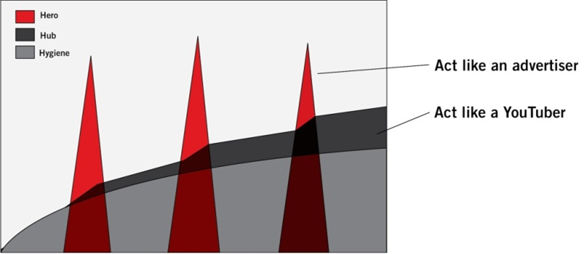
Google has long been touting its three tiered approach to video marketing on YouTube. The so called hero hub hygiene (which we prefer to call help) model is increasingly being seen by marketers as a powerful way of segmenting just about any type of marketing content and the bedrock of a rounded and effective digital marketing strategy.
But what is help hub and hero content and how can segmenting your content improve its effectiveness. These are questions I want to answer in this article, as well as looking at how you can bring this mindset to your own content marketing, bringing more focus and structure to your content strategy.
Why you should Segment your Content
In the digital space content is abundant. It’s no good for 21st century brands to fall back on the traditional approach of periodically advertising their company and products through high budget video and print advertising alone.
Nowadays the most successful online brands are the ones who have been able to build up loyal online communities and this is done primarily through a consistent and regular output of varied content across channels.
The help hub hero model is a way of segmenting these pieces of content so they are created with the right objectives in mind and thus distributed through the right channels. Objectives are based around where, when, how and to whom you are distributing your content and whereabouts in the marketing funnel the intended audience is.
Digitally savvy consumers expect companies to advertise their products and services but they also expect a lot more besides in the form of regular ‘valuable’ content they can access through social media.
The image above is a graphical representation of how the help (hygiene) hub hero model can drive brand awareness. The red peaks are the hero content which are designed for maximum exposure. The dark grey is the hub content which gains a boost off the back of each of these hero content launches. The lighter grey is the growing body of help content that drives interest and exposure through search results gradually over time.
Let’s look at each of these content types in turn.
Hero Content
Hero content is your go big content. This will invariably attract a lot more budget and should be polished and professionally produced. Hero content is designed to attract as much attention to your company as possible and as such should be distributed across a number of channels for maximum exposure. This is content that sits at the top of the marketing funnel in the ‘awareness’ stage of the consumer journey.
Calls to action are important to drive people towards your other online assets to find out more, notably your website and social media accounts.
Hero content can often rely on storytelling and emotionally driven marketing that creates strong responses in the viewer. These are not only memorable but, if done right, will help reinforce positive brand identity in the viewer.
The ‘lost scarf’ TV commercial was produced by Aspect for Nationwide and is a perfect example of hero content getting maximum exposure across television and digital channels, where it reached a huge audience.
Hub Content
Hub content is content designed to appeal to your existing customers or prime prospects. These are people who have passed beyond the ‘awareness’ stage of the marketing funnel and want to know more about your brand. This content should go beyond just self-promotion and should aim to bring genuine value to your audience.
Hub content is push content, which means that its distribution is reliant on building networks of followers and subscribers across social media and your YouTube channels. Hub content is therefore reliant to some degree on the wider exposure from your hero content marketing, which should help boost your follower numbers.
RedBull are masters of brand marketing. As well as staging supersonic skydives from the edge of the earth’s atmosphere, they also produce regular hub content aimed at their core audience demographic. Who is JOB is a prime example of this.
Help Content
The last piece of the content marketing jigsaw is help content, referred to by Google as hygiene content.
Unlike hero and hub content, help content should avoid any overt self-promotion or branding in favour of informing potential prospects and existing customers. Help content is about finding and filling in the gaps for informational online content and then optimising this content to rank well in search results. The bigger your follower base, the easier this will become.
Help content is about audience engagement and building a loyal follower base online, who will share, comment and even promote your content to their own followers. It’s also about understanding what it is your core audience is interested in and what kind of information and expert insight they’d appreciate.
Nike have perfected the use of the help hub hero model and the Nike Academy series is a perfect example of help content that has helped the company’s YouTube channel gain a huge following.
Conclusion
Companies must recognise that to be effective content creators they must know when to think like an advertiser and when to think like a YouTuber. To quote from Google’s own literature on the approach “for every brand or advertiser doing something on YouTube there's a YouTuber doing it bigger and better.”
This means creating content that doesn’t just draw attention to your brand but that can attract loyal followers by offering genuine value and insight, without pushing a marketing message down anyone’s throat. Covering all your bases isn’t easy but the help hub hero approach to segmenting your content is a powerful framework that will put you on the right track.
- Log in to post comments

